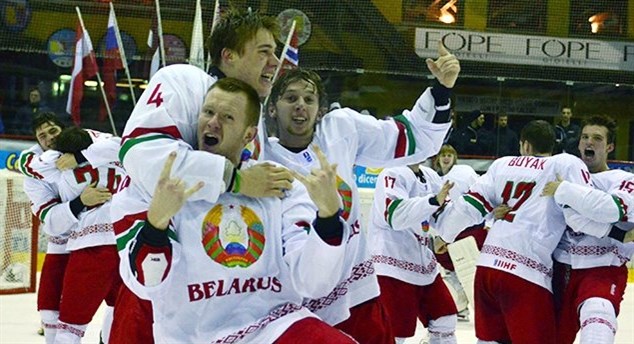
Belarus celebrations getting promoted at the 2015 IIHF Ice Hockey U20 World Championship Division I Group A in Asiago, Italy. Photo: Paolo Basso
Former Soviet republic returns for Helsinki 2016
Do you remember what you were doing on January 4, 2007? The Belarusian Ice Hockey Association remembers that date, but not fondly.
With a 9-0 loss to Slovakia at the IIHF World Junior Championship in Mora, Sweden, the Belarusians were relegated to Division I – despite featuring future NHL 20-goal scorer Sergei Kostitsyn in their lineup. Little did they know it would be nearly eight years before they got back to the elite level.
Fortunately, happier days have arrived.
Thanks to five straight wins at the 2015 IIHF Ice Hockey U20 World Championship Division I Group A in Asiago, Italy, last month, Belarus has secured promotion and is excited about competing at the 2016 World Juniors in Helsinki, Finland. Germany, having lost twice to Switzerland in relegation play in Toronto, will go down next year.
It’s part of a recent wave of hockey success for this former Soviet republic. The capital city of Minsk hosted the 2014 IIHF Ice Hockey World Championship last May. Not only did the Belarusians finish seventh under then-head coach Glen Hanlon – their second-best finish ever (after sixth in 2006, under Hanlon as well) – but they also set a new all-time tournament attendance record of 643,434.
Naturally, it’ll be hard for the U20 squad coached by Pavel Perepekhin to emulate those achievements. Perepekhin, a 36-year-old former Yunost Minsk forward who’s also worked as a KHL assistant coach with Dynamo Minsk, will only have four returning players in Helsinki at most: forwards Dmitri Buinitski and Vladislav Misnikov, and defencemen Danil Bokun and Stepan Falkovski.
Dmitri Ambrozheichik, who’s earned 23 points in 33 games with the QMJHL’s Baie-Comeau Drakkar this season, drove the Belarus attack in Asiago. He led the tournament in scoring (4-8-12) and was named Best Forward, but the 19-year-old won’t be back as many other 1995-born players.
So can Belarus possibly survive with its relatively shallow talent pool that draws principally on its domestic junior leagues?
Unlike Denmark, 2015’s newcomer to the elite division, the Belarusians won’t bring prospective future NHL stars like Nikolaj Ehlers (Winnipeg Jets, drafted ninth overall in 2014) or Oliver Bjorkstrand (Columbus Blue Jackets, drafted 89th overall in 2013). Their offensive contributions led the Danes all the way to the quarter-finals against Canada.
But there is a little reason for hope.
Belarus isn’t a total newcomer. It had five appearances in the elite U20 division prior to 2007 (1999, 2001, 2002, 2003, 2005). Hockey is a priority in this country. And Belarus has the potential to surprise.
If you know your international hockey history, you’ll recall at the 2002 Salt Lake City Olympics, Belarus pulled off what’s widely regarded as the second-biggest upset ever, after the American “Miracle on Ice” win over the Soviet Union at the 1980 Winter Games in Lake Placid.
Do you remember what you were doing on February 20, 2002? The Swedish Ice Hockey Association remembers that date, but not fondly. They lost 4-3 to Belarus in the quarter-finals as defenceman Vladimir Kopat’s shot from centre ice beat goalie Tommy Salo with 2:24 remaining.
Even if the Belarusian kids suiting up in Helsinki have only dim memories of that day, it’s an iconic, shared moment of national pride that will provide them with inspiration in the battles ahead.






